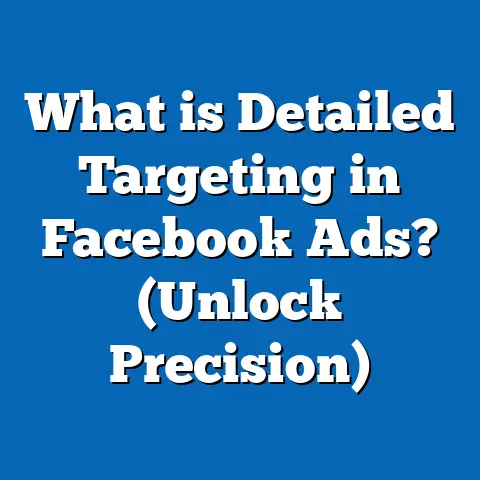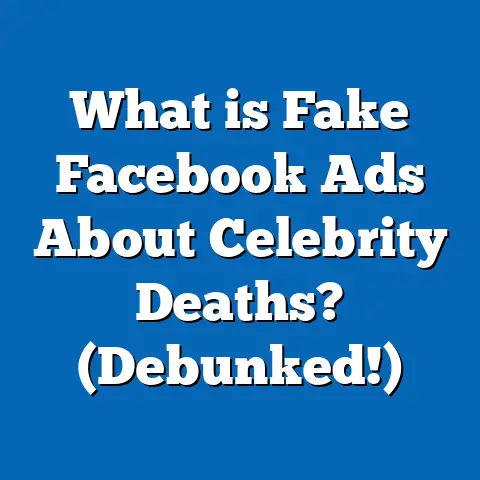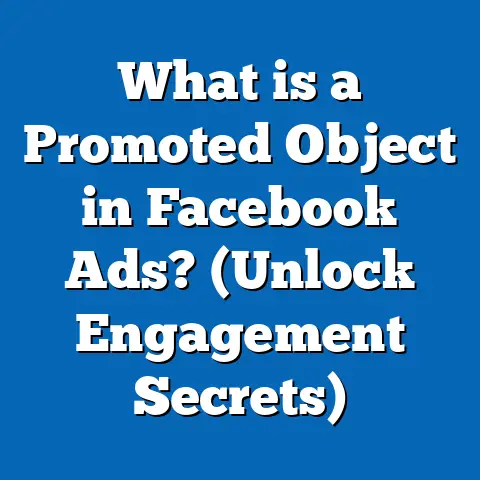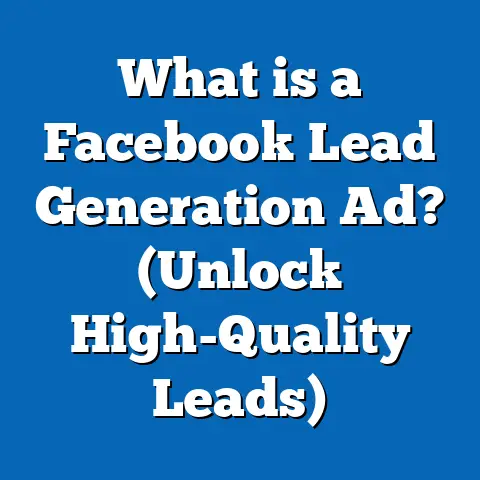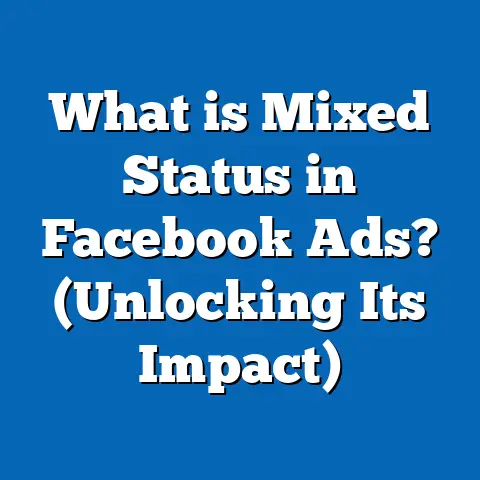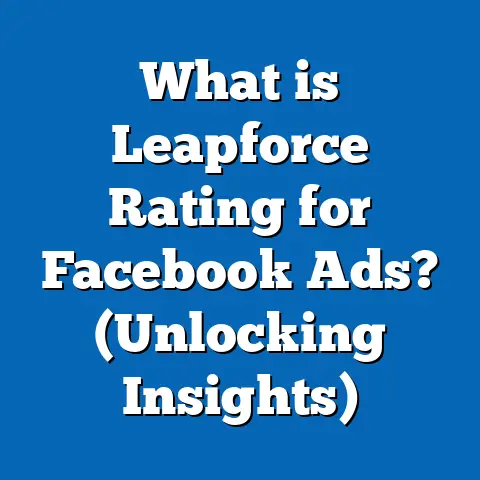What is Third-Party Ads on Facebook? (Understanding Restrictions)
Introduction: The Craftsmanship Behind Facebook Advertising and Third-Party Ads
Facebook advertising has become a cornerstone for businesses aiming to reach highly targeted audiences online. The artistry involved in crafting successful Facebook campaigns lies not only in creative design but in mastering the platform’s complex tools and options. Among these tools, third-party ads hold a special place due to their ability to streamline management and provide enhanced analytics—yet they come with a unique set of restrictions and technical requirements.
Understanding third-party ads on Facebook is essential for marketers who want to leverage the platform’s full potential while staying compliant with evolving policies. This guide will unravel the complexities behind third-party ads, provide data-backed insights, share real-world case studies, and deliver actionable strategies for marketing professionals and business owners.
What Are Third-Party Ads on Facebook?
Defining Third-Party Ads
In the context of Facebook advertising, third-party ads are advertisements created, managed, or optimized using platforms outside of Facebook’s native tools (such as Facebook Ads Manager). These platforms are usually software solutions or agencies that connect to Facebook via its Marketing API to automate ad creation, bidding, targeting, and reporting.
Third-party ads are not physically different ads from those created directly on Facebook. Instead, the distinction lies in how the ads are managed and optimized using external tools.
Types of Third-Party Ads
- Ads Managed by Marketing Agencies: Many businesses hire agencies to run their Facebook ad campaigns. These agencies often use specialized third-party software to manage multiple client accounts efficiently.
- Ads Managed Through Software Platforms: Tools such as Hootsuite, AdEspresso, HubSpot, Sprout Social, and others provide interfaces that connect with Facebook’s ad system. These platforms often offer features beyond what Facebook provides natively.
- Programmatic Ads Through DSPs (Demand-Side Platforms): Some advertisers use programmatic platforms that integrate with Facebook’s API to automate large-scale buying of ads across multiple networks.
How Third-Party Ads Work Within Facebook’s Ecosystem
Facebook’s ecosystem allows external applications to interact with its ad system via the Marketing API. This API acts as a bridge between Facebook’s backend infrastructure and external platforms.
The process generally looks like this:
- The advertiser or agency inputs campaign parameters (budget, target audience, creatives) into the third-party platform.
- The platform uses the Marketing API to create or update campaigns within Facebook.
- Facebook delivers these ads based on its auction system and targeting algorithms.
- Performance data flows back through the API into the third-party tool for analysis and optimization.
This interaction enables advertisers to manage complex campaigns more efficiently but requires adhering to Facebook’s usage policies.
Why Third-Party Ads Matter: Data and Insights
Market Share of Third-Party Tools in Facebook Advertising
Recent data highlights the growing reliance on third-party tools:
- A 2023 eMarketer report found that approximately 30% of all Facebook ad campaigns are managed via third-party platforms.
- Marketing agencies report that clients using third-party management tools see an average increase of 22% in client retention rates compared to manual management.
- Brands using integrated analytics dashboards from third-party platforms experienced a 15% faster decision-making process for campaign optimization (Source: Social Media Examiner, 2024).
Benefits of Using Third-Party Ads
Third-party platforms offer several advantages over native Facebook tools:
- Improved Efficiency
- Automation reduces manual effort in campaign setup and reporting.
- Bulk editing capabilities allow advertisers to manage hundreds of ads simultaneously.
- Advanced Analytics
- Custom dashboards aggregate data across multiple campaigns or platforms.
- Enhanced visualization helps identify trends faster.
- Cross-Channel Management
- Manage ads on Facebook alongside Google Ads, LinkedIn Ads, Twitter Ads from one interface.
- This unified approach simplifies budget allocation and performance comparison.
- Creative Testing and Optimization
- Sophisticated A/B testing tools let marketers experiment with different creatives, copy, and targeting quickly.
- Machine learning models predict winning combinations more effectively than manual trials.
- Audience Segmentation
- Integration with CRM systems allows for highly customized audience targeting based on customer behavior or demographics.
Understanding Facebook’s Restrictions on Third-Party Ads
Facebook maintains strict guidelines for third-party ads to ensure user safety, privacy compliance, and overall platform quality.
Overview of Key Restrictions
- Data Use Limitations
- Third-party platforms can only access user data allowed by Facebook’s permissions.
- Sensitive information such as personally identifiable information (PII) must not be stored or misused.
- Ad Content Policies
- All ads created through third-party tools must comply with Facebook’s advertising policies, including prohibitions against misleading content, hate speech, adult content, and discriminatory practices.
- Violations can lead to ad rejection or account suspension regardless of the platform used.
- API Rate Limits and Quotas
- To prevent abuse and server overloads, Facebook imposes limits on how frequently a third-party tool can call its API endpoints.
- These limits vary based on app type and user volume but typically range from thousands to millions of calls per day.
- Approval Processes
- Certain ad categories (e.g., political ads, health-related products) require additional approvals.
- When using third-party tools, these approval workflows may be slower due to extra layers of processing.
- Restricted Ad Formats
- Some newer or experimental ad formats may be initially available only through native Ads Manager before being accessible via API.
Reasons Behind These Restrictions
- Privacy Regulations: With laws like GDPR (Europe) and CCPA (California), Facebook must tightly control data sharing.
- Platform Integrity: To combat spam, misinformation, scams, and harmful content.
- User Experience: To ensure ads are relevant and non-intrusive so users remain engaged on the platform.
Technical Breakdown: How Third-Party Ads Are Implemented
Deep Dive Into Facebook Marketing API
The Marketing API is a RESTful interface that enables external software to programmatically manage ad accounts on Facebook.
Core Components of the Marketing API
| Component | Functionality |
|---|---|
| Campaigns | Create or modify campaigns |
| Ad Sets | Define budgets, schedules, audience targeting |
| Ads | Upload creatives and set ad copy |
| Insights | Retrieve performance metrics |
| Custom Audiences | Create or manage audiences based on external data |
| Pixels & Events | Track conversions through pixel integration |
Example API Workflow
- Authenticate with OAuth tokens linked to a Facebook Business account.
- Create a campaign object specifying objective (e.g., conversions).
- Set up one or more ad sets with targeting parameters (age, location, interests).
- Upload images/videos through the API.
- Create ads attached to ad sets.
- Monitor performance data like impressions, clicks, conversions.
- Adjust bids or budgets based on results.
API Limitations Affecting Third Parties
- Rate Limits: Apps have quotas limiting how many requests per hour/day they can make.
- Delayed Sync: Real-time updates might experience latency compared to native tools.
- Feature Gaps: Some new ad formats or targeting options might not be immediately available via API.
- Security Restrictions: Sensitive operations may require additional permissions or user consent.
Case Study 1: Digital Agency Scaling Small Business Campaigns with Third-Party Tools
Background
A digital agency specializing in local businesses faced challenges managing multiple client accounts in Ads Manager due to time-consuming manual setups and reporting delays.
Strategy
- Adopted AdEspresso for its robust A/B testing features.
- Automated daily budget reallocation based on performance metrics pulled via API.
- Integrated CRM customer data for advanced audience segmentation.
- Used automated reporting dashboards shared directly with clients weekly.
Outcome
- Average ROAS increased by 35% across clients within three months.
- Time spent on campaign setup reduced by 40%.
- Client satisfaction scores improved by 25%, attributed to transparent reporting and faster adjustments.
- Discovered new profitable audiences through combined CRM-data targeting unavailable through native tools alone.
Case Study 2: E-commerce Brand Leveraging AI-Powered Optimization Through Third-Party Platforms
Company Profile
A mid-sized e-commerce brand selling fitness apparel wanted to scale its Facebook presence but lacked in-house expertise in advanced optimization techniques.
Approach
- Partnered with a third-party platform integrating AI-driven bidding algorithms.
- Set up dynamic product ads synced with their Shopify store through the platform’s API integration.
- Automated creative testing with multiple video and image variants.
- Used predictive analytics to adjust targeting based on purchase likelihood scores.
Results
- Achieved a 50% increase in conversions within two months.
- Decreased average cost per purchase (CPP) by 20%.
- Reduced manual campaign management hours by 60%.
- Increased repeat purchase rate by targeting high-value segments identified through AI insights.
Comparing Third-Party Ads with Native Facebook Ads: Detailed Analysis
| Factor | Native Facebook Ads | Third-Party Ads |
|---|---|---|
| Access to New Features | Immediate access to all new formats | Delayed access; some features may be missing initially |
| Automation | Limited automation; requires manual setup | Advanced automation including batch edits & AI tools |
| User Interface | User-friendly but limited multi-account support | Custom dashboards optimized for multi-client workflows |
| Reporting | Standardized reports | Customizable reports integrating cross-channel data |
| Compliance Monitoring | Direct enforcement by Facebook | Must rely on tool’s compliance features + manual checks |
| API Rate Limits | Not applicable | Subject to strict rate limits |
| Integration Capabilities | Limited integration outside Facebook | Extensive integration with CRM, eCommerce platforms |
Practical Tips for Marketers Using Third-Party Ads Effectively
- Select Trusted Platforms
- Verify certifications such as Facebook Marketing Partner status.
- Review security practices related to data handling.
- Keep Up-to-Date With Policy Changes
- Regularly review Facebook’s Advertising Policies Facebook Business Help Center.
- Subscribe to developer updates about API changes.
- Monitor Campaign Performance Closely
- Compare data from native Ads Manager with third-party reports for discrepancies.
- Use alerts for sudden drops in performance or policy violations.
- Leverage Automation Judiciously
- Automate repetitive tasks like reporting but manually review strategic changes.
- Test AI recommendations rather than accepting blindly.
- Prioritize Privacy Compliance
- Ensure audiences built from CRM data comply with user consent laws.
- Avoid storing sensitive personal data not permitted by Facebook policies.
- Maintain Backup Access
- Keep access to native Ads Manager as fallback in case of third-party tool downtime or limitations.
Latest Trends Impacting Third-Party Ads on Facebook (2024)
Enhanced Privacy Measures Impacting Third Parties
With rising concerns over user data privacy:
- Aggregated Event Measurement limits pixel data visibility to aggregate-level insights rather than individual events.
- Limited Audience Size thresholds reduce micro-targeting precision.
- Restriction on sharing user-level conversion data affects retargeting campaigns run via third parties.
These trends require marketers to rethink attribution models and focus more on higher-level metrics like lift tests or incrementality studies.
Growing Role of AI in Automation Tools
Third-party platforms increasingly embed AI engines that:
- Predict optimal bidding strategies based on historical data patterns.
- Generate personalized creative variants automatically using machine learning.
- Suggest new audience segments based on lookalike modeling enhanced by behavioral signals.
This reduces guesswork and accelerates campaign scaling but requires understanding algorithmic biases and monitoring outcomes closely.
Cross-Platform Management Becoming Standard
Modern marketing demands seamless coordination across multiple channels:
- Tools now support integrated campaign management for Facebook, Instagram, Messenger simultaneously.
- Unified budgets allow dynamic allocation where performance is strongest across placements.
- Centralized reporting consolidates performance metrics from all channels for holistic ROI analysis.
Common Challenges When Using Third-Party Ads—and How To Overcome Them
| Challenge | Cause/Description | Recommended Solution |
|---|---|---|
| API Rate Limit Exceedance | Too many requests causing temporary bans | Batch API calls; schedule updates during off-hours |
| Policy Violation Due To Outdated Rules | Tool not updated with latest policy changes | Regularly update tool integrations; manual policy review |
| Data Discrepancies Between Tools | Different attribution windows or metric definitions | Cross-check metrics; align attribution settings |
| Delayed Feature Rollouts | New ad formats unavailable via API immediately | Use native Ads Manager temporarily; monitor updates |
| Security Risks | Unauthorized data access or breaches | Use secure tokens; restrict access rights; audit logs |
| Difficulty Tracking Multi-client Accounts | Complex account hierarchies cause confusion | Use Business Manager structure properly; clear naming conventions |
Advanced Insights: Legal Considerations for Third-Party Ads on Facebook
Compliance With Data Protection Laws
Facebook itself complies with regulations like GDPR and CCPA but responsibility also lies with advertisers and third-party tools:
- Advertisers must obtain explicit user consent when utilizing customer data for targeting.
- Data processors (third-party tools) must ensure secure storage and limit processing scope as per contracts.
Failure to comply can result in heavy fines and reputational damage.
Transparency Requirements
Facebook requires advertisers to be transparent about who is running political or issue-based ads:
- Third-party platforms must facilitate disclaimers where applicable.
- Agencies must ensure proper authorization is documented when managing client campaigns involving sensitive topics.
Educational Spotlight: Explaining Key Terms Related to Third-Party Ads
To ensure clarity for all readers:
| Term | Explanation |
|---|---|
| Marketing API | Interface allowing external software to interact with Facebook’s ad system |
| Custom Audience | Target group created from customer lists or website visitors |
| Lookalike Audience | Audience similar in characteristics to an existing audience |
| Pixel | Tracking code embedded on websites to measure conversions |
| ROAS | Return On Ad Spend – revenue generated per dollar spent |
| Rate Limit | Maximum number of API requests allowed in a time period |
Summary: Key Takeaways for Mastering Third-Party Ads on Facebook
- Third-party ads offer powerful automation and analytics but come with strict restrictions designed to protect privacy and maintain quality.
- Deep understanding of the Marketing API is essential for leveraging these tools effectively.
- Data shows that agencies and brands using third-party platforms often enjoy higher efficiency, better optimization, and improved ROI.
- Privacy regulations continue to evolve rapidly—staying compliant requires proactive adaptation.
- Combining native tools with trusted third-party platforms provides flexibility and robustness.
- Continuous learning about policy updates, technical capabilities, and industry trends will keep marketers ahead of challenges.
Next Steps for Marketers and Business Owners
- Conduct a thorough audit of any third-party tools currently used for Facebook advertising.
- Invest time in training your team on both technical API knowledge and evolving advertising policies.
- Experiment cautiously with automation features while maintaining human oversight.
- Monitor performance across both native and third-party dashboards regularly for discrepancies or issues.
- Stay connected with industry updates through official Facebook channels and trusted marketing news sources.
By following these steps, marketers can harness the full potential of third-party ads on Facebook without risking compliance or performance setbacks.
If you want additional sections such as a glossary of terms specific to Facebook advertising APIs, extended case studies by industry verticals (e.g., retail vs B2B), or more hands-on how-tos for tool setup and optimization workflows, please let me know!

